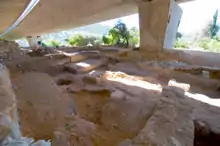Tel Motza temple
The Tel Motza temple is an ancient Israelite temple located in the area of Motza on the outskirts of Jerusalem, discovered in 2012 by Israeli archaeologists.
History

Excavations at Tel Motza carried out prior to construction on Highway 1 revealed a public building, storehouses and silos dating to the days of the monarchal period (Iron Age IIA). A wide, east-facing entrance in the wall of the public building is believed to have been built in accordance with temple construction traditions in the Ancient Near East: the sun rising in the east would illuminate an object placed inside the temple, symbolizing the divine presence.[1]
An array of sacred pottery vessels, chalices and small figurines of men and horses were found near the altar of the temple. The cache of sacred vessels has been dated to the early 9th century BCE,[2] that is before the centralising religious reforms of Kings Hezekiah (reign ca. 729–687 BCE) and Josiah (reign ca. 640–609 BCE) of Judah.[1][3]
The temple dates back to the Kingdom of Judah of the 9th century BCE, and appears to have operated alongside the First Temple in nearby Jerusalem.[4][5] Jerusalem was the centre of the Kingdom of Judah and, according to the Hebrew Bible, the seat of kings David and Solomon.[3] Many historical finds have been discovered in the area of Tel Motza, dating from different periods, and archaeologists have sought to identify it as the Biblical settlement of Mozah mentioned in the Book of Joshua (Joshua 18: 26).[6]
The archaeological site directors said the discoveries provided evidence for the existence of temples and ritual enclosures throughout the Kingdom of Judah before the religious reforms centralized ritual practices at the Temple in Jerusalem. The temple was a rare find of remains from the First Temple period.[3]
Animal bones were found at the site, and show signs of having been cut, possibly indicating that they were sacrificed.[5]
Occupation earth with one of the first remains of buildings, statuettes and bones of domesticated animals in the temple's area and nearby goes back to about 7,000 BC.[7] This older part is to be buried by Jerusalem Road 16 in 2019 after development-led excavation.
References
- First Temple Period Ritual Structure Discovered Near Jerusalem
- Kisilevitz, S. 2015. The Iron IIA Judahite Temple at Moẓa. Tel Aviv 42:147-164.
- "Davidic-era temple unearthed in dig near Jerusalem". The Times of Israel. Retrieved December 27, 2012.
- "Temple and rare cache of sacred vessels from Biblical times discovered at Tel Motza (December 2012)". Israel Antiquities Authority. Retrieved July 27, 2016.
- "Israeli archaeologists uncover ancient temple just outside Jerusalem". Haaretz. Retrieved December 27, 2012.
- "Dig uncovers temple, sacred vessels". Ynet. Retrieved December 30, 2012.
- Friedman, Matti (August 29, 2012). "Ancient animal figurines unearthed outside Jerusalem: Two 9,000-year-old statuettes come from era that saw start of domestication of animals". The Times of Israel. Retrieved November 24, 2018.